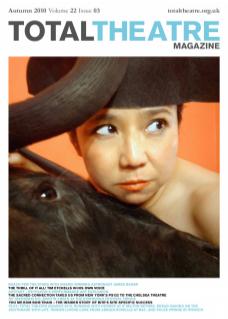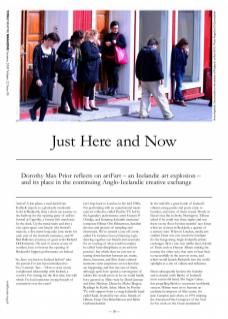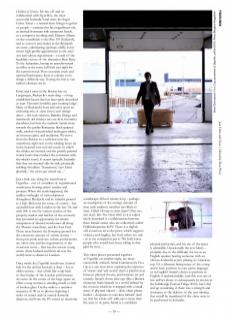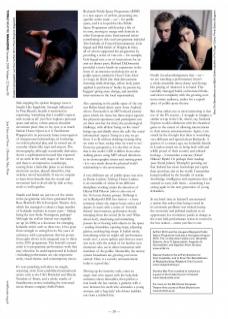Arrival! A late plane, a mad dash from Keflavík airport to a gloriously modernist hotel in Reykjavík, then a short car journey to the harbour for the opening party of artFart festival at Útgerðin, a former fish warehouse by the dock. Up the metal stairs and into a vast open space: one bicycle (the festival’s mascot), a five-metre long cake (one metre for each year of the festival’s existence), and 99 Red Balloons (courtesy of guest artist Richard DeDomenici). Oh and of course scores of revellers, here to honour the opening of Reykjavík’s hippest performance art festival.
‘So, have you been to Iceland before?’ asks the person I’ve just been introduced to. ‘No,’ I answer, ‘but…’ How to start on my complicated relationship with Iceland, a country I’m visiting for the first time, but with which I’ve had numerous strong threads of connection over the years?
Let’s hop back to London in the mid 1980s. I’m performing with an experimental music cum art collective called Psychic TV, led by the legendary performance artist Genesis P Orridge, and featuring Icelandic musician/ composer Hilmar Örn Hilmarsson, Scriabin devotee and pioneer of sampling and electronica. We’ve created a one-off event called The Fabulous Feast of Flowering Light, drawing together our friends and associates for an evening of what would nowadays be called ‘inter-disciplinary cross-artform practice’, but which then we just saw as tearing down barriers between art, music, dance, literature, and film. Some cultural moments seem auspicious even when they are happening, and this was one of them, although quite how special a convergence of talents this would prove to be we could hardly have guessed at. Films were by Derek Jarman and John Maybury. Dance by Micha Bergese. Readings by Kathy Acker. Music by Psychic TV, with support from a young Icelandic band called Kukl, fronted by two close friends of Hilmar, Einar Örn Benediktsson and Björk Guðmundsdóttir.
In the mid-80s a great horde of Iceland’s vibrant young punks and poets came to London, and some of them stayed. Mostly in Einar’s tiny flat in Stoke Newington. ‘Hilmar asked if he could stay three nights and was there on my floor for nine months’ says Einar when we re-meet in Reykjavík a quarter of a century later. When in London, media arts student Einar was very much the lynchpin for the burgeoning Anglo-Icelandic artistic exchanges (first a one-way traffic; later, friends of Einar such as Damon Albarn making the journey the other way) that were to bear fruit so successfully in the years to come, and which would launch Reykjavík into the world spotlight as a city of culture and influence.
Einar subsequently became the founder and co-leader (with Björk) of Iceland’s most successful band, The Sugar Cubes, this propelling Björk to enormous worldwide success. Hilmar went on to become an acclaimed composer of film scores, for Jane Campion and others, in 1991 winning the European Film Composer of the Year for his work on the Oscar-nominated Children of Nature. He has off and on collaborated with Sigur Rós, the most successful Icelandic band since the Sugar Cubes. Einar – a natural-born bringer-together of people – continued in his magnificent role as musical frontman with numerous bands, as a composer (working with Damon Albarn on the soundtrack to the film 101 Reykjavík), and as a mover and shaker in the Reykjavík art scene, culminating (perhaps oddly) in his recent high-profile appointment to the city’s arts and culture department – a result of the landslide victory of the alternative Best Party. To the Icelanders, having an anarchist-punk in office at the town hall feels just right for the current mood. Post economic crash and national bankruptcy, there is a desire to do things a different way. Towing the line is out; radical solutions are in.
Einar and I meet in the Boston bar on Laugavegur, Reykjavík’s main drag – a long-established haunt that has been aptly described as ‘part Victorian bordello, part hunting lodge’. Many of Reykjavík’s bars and cafes sport an endearing mix of objets trouvés and vintage décor – 60s teak cabinets, Bakelite fittings and mammoth old wireless sets are firm favourites elsewhere, but here the aesthetic bends more towards the gothic-Romantic: black-painted walls, mother-of-pearl inlaid mahogany tables, art nouveau glass, and taxidermy. We move from the Boston to a sushi bar near the waterfront, right next to the whaling boats (as in the battered rust-red old vessels in which the whales are hunted, and the prettily-painted tourist boats that conduct the commune-with-the-whales tours). It seems typically Icelandic that they are moored side-by-side, practically rubbing shoulders. ‘Sometimes,’ says Einar gleefully, ‘ the crews get mixed up…’
Just a little way along the waterfront is Útgerðin – one of a number of requisitioned warehouses hosting artists’ studios and projects. When the crash happened, the endless onslaught of redevelopment throughout Reykjavík and its suburbs ground to a halt. Bad news for some, of course – but a parallel here with London in the late 70s and early 80s: it was the various crashes of the property market and lurches of the economy that provided an opportunity for artistic occupation of disused warehouses all along the Thames waterfront, and the East End. These areas became the flowering ground for the enormous amount of artistic activity – from post-punk and rave culture, performance art, street arts, and the regeneration of the visual arts scene – that was the reason young artists (from Iceland and from all over the world) were so drawn to London.
Once inside the Útgerðin warehouse (central hub for the artFart festival), it does – for us oldies anyway – feel a little like a trip back to that heyday of the London performance art scene. In the centre of the large space an effete young woman is standing inside a circle of broken glass. On the walls is a narrative sequence of 80 or so photos depicting a series of minor and/or surreal domestic disasters, and from the PA comes an electronic soundscape (fifteen minute loop – perhaps an assumption of the average amount of time each audience member was likely to stay). Called Hvernig var þinn dagur? (How was your day?), this ‘live short film’ as it is rather nicely described is a collaboration between three female artists who are collectively called Fjöllistahópurinn KÁV. There is a slightly self-conscious air to the piece, which suggests violence and fragility, but feels rather too safe – or as my companion put it: ‘We both know people who would have been rolling in that glass by now…’
Two other pieces, presented together at Útgerðin on another night, are more successfully realised. Smári Gunnarsson’s I’m a Cop is a one-man show exploring the tripwires of ‘status’ and ‘self worth’ that’s a playful cross between physical theatre, performance art and comedy. Smári’s clown alter-ego (like a Beckett character) finds himself in a world defined by the room in which he is trapped with a small array of physical objects – desk, chair, plastic bucket – desperate to convince himself (and us) that his whole self adds up to more than the sum of its parts. Smári is a confident physical performer, and his use of the space is admirable. Occasionally the text falters – probably due to the difficulty for me as an English speaker hearing someone with an obvious Icelandic accent playing an American cop. It’s a dilemma facing many of the young artists here: perform in your native language or in English? Smári’s choice to perform in English is understandable (and this was one of two artFart shows to subsequently be shown at the Edinburgh Festival Fringe 2010), but I did end up wondering if there was a strength and resonance to the delivery of the text missing that would be manifested if the show were to be performed in Icelandic.
Side-stepping the spoken language issue is Snædís Lilja Ingadóttir. Strongly influenced by Pina Bausch, Snædís is interested in expressing ‘something that I couldn’t express with words at all’. Just Here! explores personal space and safety; a three-person absurdist movement piece that, to my eyes, is as much Station House Opera as it is Tanztheater Wuppertal in its perversely funny interrogation of interpersonal relationships, its bordering-on-violent physical play, and its surreal use of everyday objects like cups and saucers. The choreography, although occasionally derivative, shows a sophistication beyond that expected of an artist in the early stages of her career, and there is an impressive soundscape, veering from a Satie-like piano to an intense electronic section, played/mixed live, that switches mood beautifully. It was no surprise to learn from Snaedis that the sound and movement had evolved side-by-side as they work so well together.
Snædís and Smári are just two of the artists in the programme who have graduated from Rose Bruford’s BA in European Theatre Arts, which has managed to attract a large number of Icelandic students in recent years – Sidcup being the new Stoke Newington, perhaps? Although the artFart festival was originally set up (in 2006) as a showcase for emerging Icelandic artists such as these two, it has gone from strength to strength in its five years of existence, with a programme that has grown from eight shows in its inaugural year to thirty in the 2010 programme. The festival’s current remit is to programme performance work that may otherwise be under-represented in Iceland – including performance art, site-responsive work, visual theatre, and contemporary circus.
It’s now punching well above its weight, attracting visits from established international artists such as the UK’s Bottlefed and Mischa Twitchin of Shunt, and a whole swathe of Scandinavian artists, including the renowned circus-theatre company Stella Polaris.
Reykjavík Public Space Programme (RPSP) is a new aspect of artFart, presenting sitespecific works made – yes – for public space, and it is hoped that the Public Space Programme will develop a life of its own, moving to merge with festivals in other European cities. International artists contributing to this year’s programme included Tim Etchells of Forced Entertainment, Gob Squad and Phil Smith of Wrights & Sites, all of whom supported the programme by providing a series of rule sets – for example, Gob Squad sent a set of instructions for an anti-art dinner party. Richard DeDomenici provided a more hands-on experience in the form of an intensive workshop for art in public spaces entitled It Doesn’t Take Much to Change the World (the final denouement featuring chalk drawings, yellow body paint applied to performers’ bodies by passers-by, ‘beggars’ giving away change, and anarchic interventions in the local supermarket).
Also operating in the public space of the city was Berlin-based dance artist Anna Asplind, whose Dancewalks is an MP3-relayed journey piece which for Anna has three major aspects: the physical experience (and participants can set their own bar for this!); the psychological challenge, with all that ‘being on the street’ brings up; and thirdly what she calls ‘the social information’ aspect: ‘living in a city, we go from A to B, without thinking, hearing what we want to hear, seeing what we want to see’. From my perspective, it is the first of these that is the work’s USP: it differs from other walking pieces using MP3 relayed directions in its choreographic intent and starting point – it is very much about the physical body’s relationship to the environment.
A very different use of public space was seen in Homo Ludens’ Fjöltengi. Homo Ludens is an ensemble of artists from different disciplines working under the direction of Hlynur Páll Pálsson (who is also one of the 16 Lovers theatre group). Fjöltengi is set in Reykjavík’s BSÍ bus station – a busy terminus where the airport buses arrive and depart. It starts with a series of ‘invisible theatre’ interventions, performers slowly emerging from the crowd (Is he one? What about her?), shadowing and mimicking passers-by or fussing with objects in the space – reading timetables, opening maps, adjusting glasses, undoing bag straps. It builds nicely, introducing what we might call ‘performance mode two’, a more upbeat and obvious street arts style, with the arrival of far brasher new characters who are in direct interaction with members of the public. Meanwhile, the tannoy system broadcasts are growing ever more surreal: ‘Here is a security announcement: today is a good day.’
Moving up the intensity scale, enter an angry man who argues with the help desk assistants about timetables, then pitches a tent inside the bus station; a guitarist with a rose between his teeth who serenades a young woman; and a ‘bag lady’ who blows bubbles out from a rubbish bin.
Finally (in acknowledgement that – yes – we are watching a performance) there’s a whole-ensemble jittery dance and Stomplike playing of whatever is to hand. This carefully managed build, orchestrated finale, and clever complicity with the growing-evermore-aware audience, makes for a superb piece of public space theatre.
But what strikes me as most interesting is that use of the PA system – I struggle to imagine a similar set-up in the UK, where, say, National Express would collaborate with the theatrical game to the extent of allowing interventions to their tannoy announcements. Again, I am struck by the thought that there is something very different and special about Reykjavík. A quarter of a century ago, my Icelandic friends in London struck me as being both wild and wildly proud of their country and cultural heritage – I remember someone (Einar? Hilmar? Björk? Or perhaps their madcap poet friend Johnny Triumph?) pointing out that Iceland has more bookshops per capita than anywhere else in the world. I remember being humbled by the breadth of artistic knowledge, intelligence and experience they all seemed to carry with them – something I am seeing again in the next generation of young Icelanders.
In my brief time in Iceland I encountered a nation that rather than being cowed by its economic problems was instead seeing the economic and political mayhem as an opportunity for revolution: punks in charge at the town hall; performance artists in control in the bus station – seems just fine to me.
ArtFart 2010 and the inaugural Reykjavik Public Space Programme took place throughout August 2010. The co-directors/curators are: Alexander Roberts, Arna Ýr Sævarsdóttir, Ásgerður G Gunnardóttir, and Sigurður Arent Jónsson. www.artfart.is
Special thanks to the artFart directors for their hospitality, and to Einar Örn Benediktsson of Reykjavikurborg (Reykjavik City Council). www.reykjavikurborg.is
Dorothy Max Prior travelled to Iceland as a guest of the Trade Council of Iceland. www.islandsstofa.is/en
For more on the BA (Hons) European Theatre Arts course at Rose Bruford see www.bruford.ac.uk



